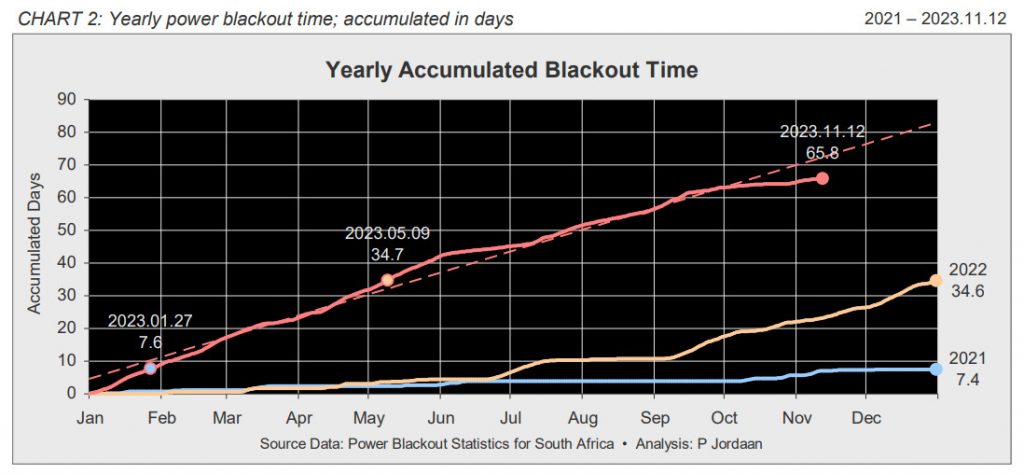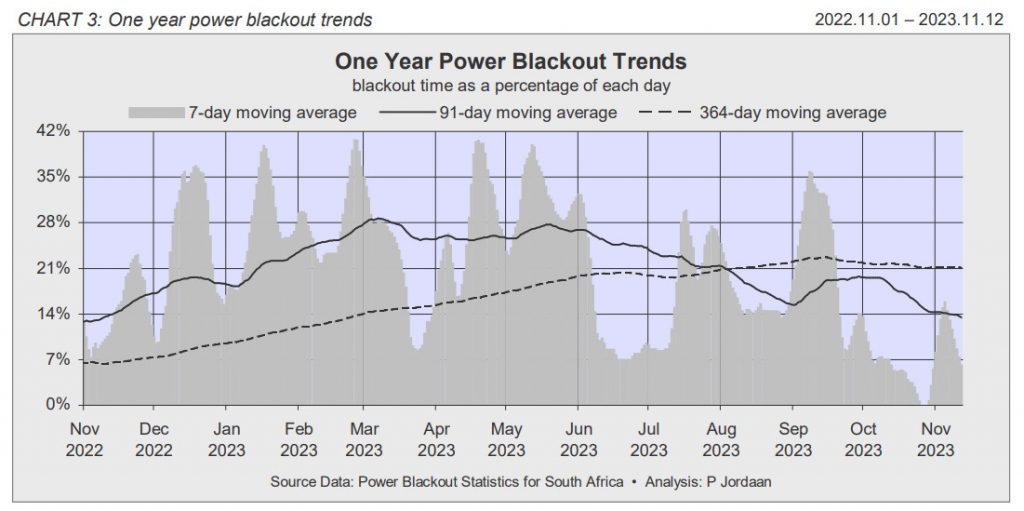South Africans are saving the day for Eskom

By cutting back on power demand, South African energy users are largely to thank for the country’s improved electricity situation.
According to the latest Power Blackout Statistics compiled by independent energy analyst Pieter Jordaan, South Africa’s energy gap has narrowed significantly since around mid-September, pulling the country back from a bleak trendline that would have seen the average household being without electricity for almost a full three months of the year, cumulatively.
In September, the blackout trend for the country showed that households were on track to double the number of blackout hours experienced in all of 2022 (34.6 days) by mid-October. However, by mid-November, this was still not the case.
“So far, the blackout meter has accumulated 65.8 days for 2023 after adding 0.5 days this week, and it is projected to accumulate 76 days over the whole calendar year,” Jordaan said.
This is a significant departure from the situation just a couple of months ago, and the full-year total blackout hour outlook is now a whole ten days (240 hours) lower than forecasts in September.
According to Jordaan, the change in fortune is thanks to a sudden downward shift from typical power demand, which started to narrow the energy gap from around mid-September.
“This has slowed the accumulation of blackout time to the extent that the marker has now deviated from its linear trend (dashed line) by 6.6 accumulated days or around 10%,” he said.

This has also been evident in Eskom’s data from previous weeks, which recorded a significant dip in user demand. During this time, the group was able to suspend load shedding for extended periods – like giving the country a 9-day streak of no outages.
However, It must be noted that the utility also had to burn through more diesel over this period, as lower power demand is still insufficient to meet the country’s energy shortfall. The suspension streak ended as soon as colder weather set in, and demand spiked up.
Looking at the more near-term trend data, the 7-day blackout trend (weekly) improved by 9.7 points to end the week below stage 1 at 6.2%. This is down from the stage 4 and stage 5 averages experienced in September.
Again, Jordaan said that the improvement is mainly due to sunny weather that tamped down power demand. More recently, however, lower levels of plant maintenance by Eskom have also added to capacity.
To this point, Jordaan said that this runs counter to “political claims” being bandied about regarding Eskom’s performance – specifically around “higher plant maintenance levels”.
“Eskom data shows that plant maintenance has fallen four days behind over the last 13 weeks (Weeks 32 – 44) compared to levels for the same period in 2022 – and seven days behind, compared to those for 2021,” Jordaan said.
The 91-day (quarterly) blackout trend retreated enough (-0.7 points to 13.5%) to end the week below the stage 2 level for the first time in a year.
The 364-day (annual) blackout trend also benefited (-0.2 points to 21.1%) from the short-term recovery, ending the week just above the stage 3-mark.

Read: Load shedding still tearing away at South Africa’s biggest retailer




















